- Details
AFAM: Hello, JB, and thank you for this interview. Your Linkedin profile says that you are a Strategist and Data Scientist, currently working out how to help small businesses out of the COVID-19 crisis. What is your every day job? Could you tell us more, please?
JB: That is the beauty of corporate strategy, there is no such thing as a typical day. I usually say that we do three things:
- Answer critical, strategic questions from our C-suite (what is the impact of COVID on our clients) to help their decision-making process
- Identify and create data assets that can bring value to the company
- Evangelize and train the organization to root their decision-making process in data and science. In a not-so-distant future, every analyst will wake up in the morning and fire up a tool that will tap into millions of rows of data. They won’t need me anymore when we get there. Until then my job is not done.
AFAM: How and when did you develop interest in finance?
JB: Around the time I was graduating, I met a group of consultants that worked on some niche financial products called weather derivatives (basically financial products except the underlying asset is the number of days of rain in Nice and not the S&P500). It was fun, quirky and math-heavy. I then went on to do Corporate Strategy, then Data Science, all in the banking sector.
AFAM: Why did you choose working in finance? What inspires you in this sector?
JB: I work in Small Business Banking. In the USA, 30 million small businesses make up for half of the employment. They are a critical part of our economy and one of the last places where people get to live the American dream. Helping them through the COVID crisis, watching the incredible resilience of the sector and the business owners is awe-inspiring. On top of that, the revolution that is underway in the financial sector, with data becoming front and center of all decisions is amazing. I really think that a few years from now, everyone will be all equipped with the tools of data science. We will look back and won’t believe how archaic the pre-big-data ages were, just like we pain to imagine a world without laptops and cellphones.
AFAM: What challenges do you face in your job?
JB: We are leading a revolution in a sense that traditionally, IT and data science operate in a silo from decision makers. While a CEO or a strategist needs an answer in the next couple of weeks to steer the company in the right direction, traditional IT and data scientist tend to stretch projects over months. And traditional strategists usually have a very shallow understanding of the data landscape, meaning they will ask for data that might not even exist. We get people out of their comfort zone, pushing IT and Data Scientists to understand the real-life impact of their work, and forcing strategists to really dive into the data and the science to get answers. Once they see what they can achieve, the impact they can have, they never look back. But getting them there is sometimes a daunting task.
AFAM: Are there any promising fintech startup in the US or in France you are following?
JB: I follow very closely the big (usually payment centered) startups, such as Square, Paypal, or Intuit. I find their move upmarket and into traditional banking products very interesting. While they are not fully equipped today to deal with complex clients, they undoubtedly have some competitive advantages around client experience, and integration of products that keep us on our toes.
AFAM: What piece of advice could you give to our students willing to get started in finance, for instance, those who would like to come to the US in 2021 to pursue a financial internship?
JB: Push yourself to find your differentiating factor, for the right crew. It might sound cheesy but I found the only way I can be motivated is if I believe in what my team is doing (helping small businesses) and I am contributing in a way no one else is (transitioning the organization to a data-and-science-driven one) Also find something fun to do. Not necessarily the most prestigious or highest paid job, but the one that is fun. Prestige will come later.
AFAM: and we would add, dear students, do not forget to contact AFAM and apply for our Shasta program. Thank you, very much Jean-Baptiste, for this inspiring conversation about your job and the future of finance.
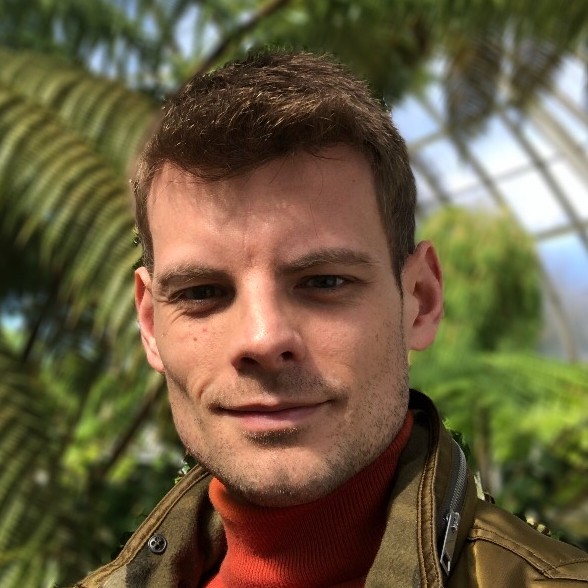
Photo: courtesy of Jean-Baptiste Commans
More interviews in our "Financial Engineering" series:
Interview with Sacha Ghebali (Bo 211)
Interview with Jean-Rodolphe Guis (Bo 99)
Interview with Imane Sanhaji (Cl 211)
- Details
On Sunday, September 12, 2020, NYC-based groupe on the initiative of its president Sacha Ghebali, organized a picnic in Central Park.
5 gadzarts came to enjoy last days of summer and first days following lock down and drastic limits setting on social gatherings.
AFAM asked Sacha Ghebali to provide a few details about the first NY-based gadz's gathering: "Following the reopening of terraces and museums, we had a survey asking our NY members if they wished to have an in-person event and with what degree of comfort with respect to social distancing, group size, having beverages, etc. The goal was to be as inclusive as possible whilst ensuring everyone would feel at ease. It was such a beautiful day to gather in Central Park, the conversation was lively and concluded on a set of elbow checks, already looking forward to the next one!"
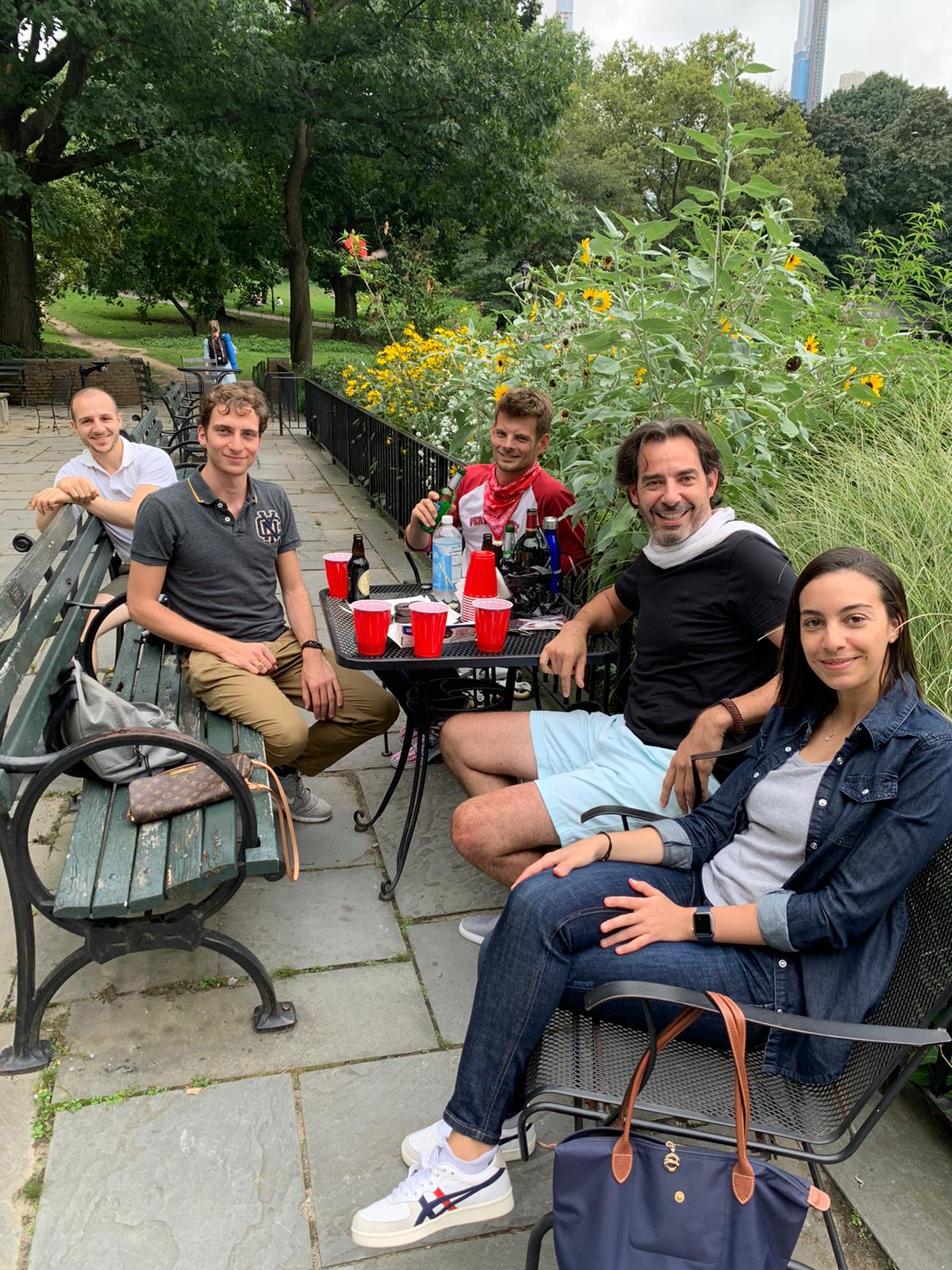
On the picture: Imane, Paul-Emmanuel, Sacha, Yacine and Jean-Baptiste during the picnic
- Details
AFAM: Hello, Imane, and thank you for this interview. You have been working as Associate in Credit Suisse in NYC for 5 years. What is your every day job? Could you tell us more, please?
Imane: I am part of the Corporate Development - Group Strategy and M&A team. Our team reports to the CEO office with dotted reporting into the CFO as well, and we get involved in either Management Consulting/Strategy projects (e.g. Credit Suisse wants to enter a new market or develop a new product, what is the opportunity and path forward; assist senior management in setting the strategic objectives of the bank and divisions and identify areas of growth and restructuring etc.); as well as M&A transactions that involve Credit Suisse Group or one of its entities as a principal.
AFAM: How and when did you develop interest in finance? I see that one of your first internships took place at Societe Generale as Assistant Trader. Is it how you got started in finance?
Imane: This first internship was indeed my first experience with Finance that confirmed my interest in pursuing afterwards a Master in Financial Engineering at NYU and led me joining Credit Suisse.
AFAM: Why did you choose working in finance? What inspires you in this sector?
Imane: I would say that my attraction originated from the fact that I saw Finance and especially Markets as an applied math’s field and I was always passionate about Mathematics. It's also a field that has such great impact on our daily lives and the evolution of societies that I couldn't imagine not understanding those intricacies. Finally, I also had numerous close examples amongst my family and friends that pursued careers in Finance so I had a pretty good idea of the working environment and the career development opportunities.
AFAM: What challenges do you face in your job?
Imane: I would say the biggest challenge is that every project and transaction is often a new topic, business model, market or product and our team's value and expectations from our internal stakeholders reside in being able to grasp complex concepts in a short amount of time and think through situations in a structured and thorough way to propose solutions and make recommendations to senior management. But that's also what makes it exciting, even more so because we cover all Credit Suisse businesses and geographies. Another challenge is being able to manage and get a handle over large scale projects or transactions that are often cross-regional and cross-divisional in nature and thus bring their fair share of internal politics...
AFAM: Imane, what piece of advice could you give to our students willing to get started in finance, for instance, those who would like to come to the US in 2021 to pursue a financial internship?
Imane: I think being able to land an internship without having been through the US education system is though in the US for US or UK banks. However, French banks offer VIEs and that's an amazing opportunity in itself. I would advise that if someone is looking for an internship in Finance while at Arts et Métiers, that they target the UK off-cycle internship programs that are used to recruiting outside of the UK universities.
For those currently completing programs in US universities, I would advise to prepare/apply early-on for interviews (as soon as the fall semester starts, decisions are made by December/January for the next summer internships or graduate programs); focus on behavioral questions and on projecting a level of confidence that equates that of US students (I don't think it comes as naturally to us); take advantage of networking opportunities through your college and really put yourself out there, and read the news and Finance articles if not already a habit. Finally, if you are looking to pursue a career in Markets more specifically, I would encourage you to learn coding in at least one language as I think this is a mainstream skill nowadays and truly believe it will always be useful in the most unexpected ways even if you don't use it on a daily basis and will make a big difference.
AFAM: We can just add to his one thing: apply for our Shasta program to find a mentor and advice from AFAM if you want to find an internship in the US in 2021. Imane, thank you for your time and have a nice day!
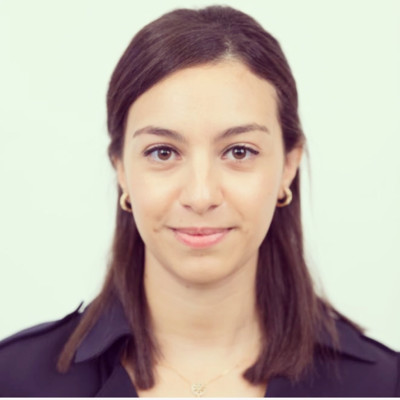
Photo: courtesy of Imane
More interviews in our "Financial Engineering" series:
Interview with Sacha Ghebali (Bo 211)
Interview with Jean-Rodolphe Guis (Bo 99)
- Details
AFAM: Hello, Jean-Rodolphe, and thank you for participating in this interview series. Please tell us a few words about yourself. What do you do on a daily basis for your job?
Jean-Rodolphe: I am currently enjoying London on my way back from the US leveraging on the Anglo-saxon culture but closer to Europe. In my job I manage a pretty large team split between London and Paris with weekly trips to Paris. It mainly consists in ensuring the third line a defense as periodic control for the Group. It is a key internal audit function for the Bank while covering all the EMEA Global Markets and ALM treasury activities. My teams are performing audits to ensure the respect of the Group policies and procedures.
AFAM: How did you get where you are now? Given that at Arts et Metiers you were mostly studying industrial and mechanical engineering, how come that you ended up working as Deputy head of IG for Global Markets and ALM T at BNP Paribas?
Jean-Rodolphe: This is obviously not straight forward from my academically background and my current position. Nevertheless, there is a logic in my career which started at PwC and following a PhD preparation (DEA) in Paris at the same time of my third year at Arts et Metiers. After 8 years in strategic financial risks consulting I have switched to Risk management in banking at BNPP. Monitoring the Bank risks - mainly credit, market and counterparty risks - for a third of the bank, I had the opportunity to lead the risk stream for a major project in New York and San Francisco tackling all risks types for Global Markets activities and retail. It leads quite logically to my current position. Eventually the mental structure and the mathematical basis provided by the Arts et Métiers are key strength to leverage upon in banking with models and governance structure. It helps a lot as well while managing massive programs.
AFAM: You have been living in NYC for 4 years and now you live and work in London. Can you tell us a bit more about this change and where do you prefer to live and work?
Jean-Rodolphe: indeed, I miss New York and the thrill of the day to day life in the Big Apple... especially the New York Road runners’ races over the week end or Central Park runs at any time of the day and night. That said London is for me the perfect mix of Anglo-Saxon culture and European close location (even if UK is getting out of the EU - unfortunately!). This is a great step after the US to be able to get in London with such a dynamic and business-oriented mindset - it is almost as thrilling as in New York. The life style is very different in a large house with space and a small back yard. London parks are great to keep healthy runs year long without the heavy snow in winter and Manhattan heat in summer... as I said the best of the 2 worlds!
AFAM: What are the biggest challenges of your job?
Jean-Rodolphe: The biggest challenge of my job is to meet the regulatory expectations which are high and making sure to enforce the protection of the Group interest against wild practices or mis-conduct. The current remote working and geographical split between the 2 parts of the team is also a huge step between 2 cultures and way of working.
AFAM: What would be your advice to our students who would like to start in the finance industry (especially those who are willing to find an internship in the US or in Great Britain in 2021)?
Jean-Rodolphe: This is obviously a matter of willingness to learn and develop skills in a different environment. It requires open minds and work as per any start. Indeed, a finance degree in addition would be a plus in the most technical jobs but nothing is impossible while working hard on your own. The finance industry is currently facing news challenges in recruiting in retaining talents so I know there are a lot of opportunities to be leveraged upon - with a good level of English to start with and clear ideas on personal ambition ... just believe in yourself and go for it!
My initial internship with Merill Lynch within their Wealth Management department in New York has been instrumental in driving the beginning of my career. In essence both the experience and the brand helped out in orienting my career. The main driver for a Gadz to work in Finance is the open mind and the willingness to explore new subject discovering new fields.
AFAM: Thank you for your time!
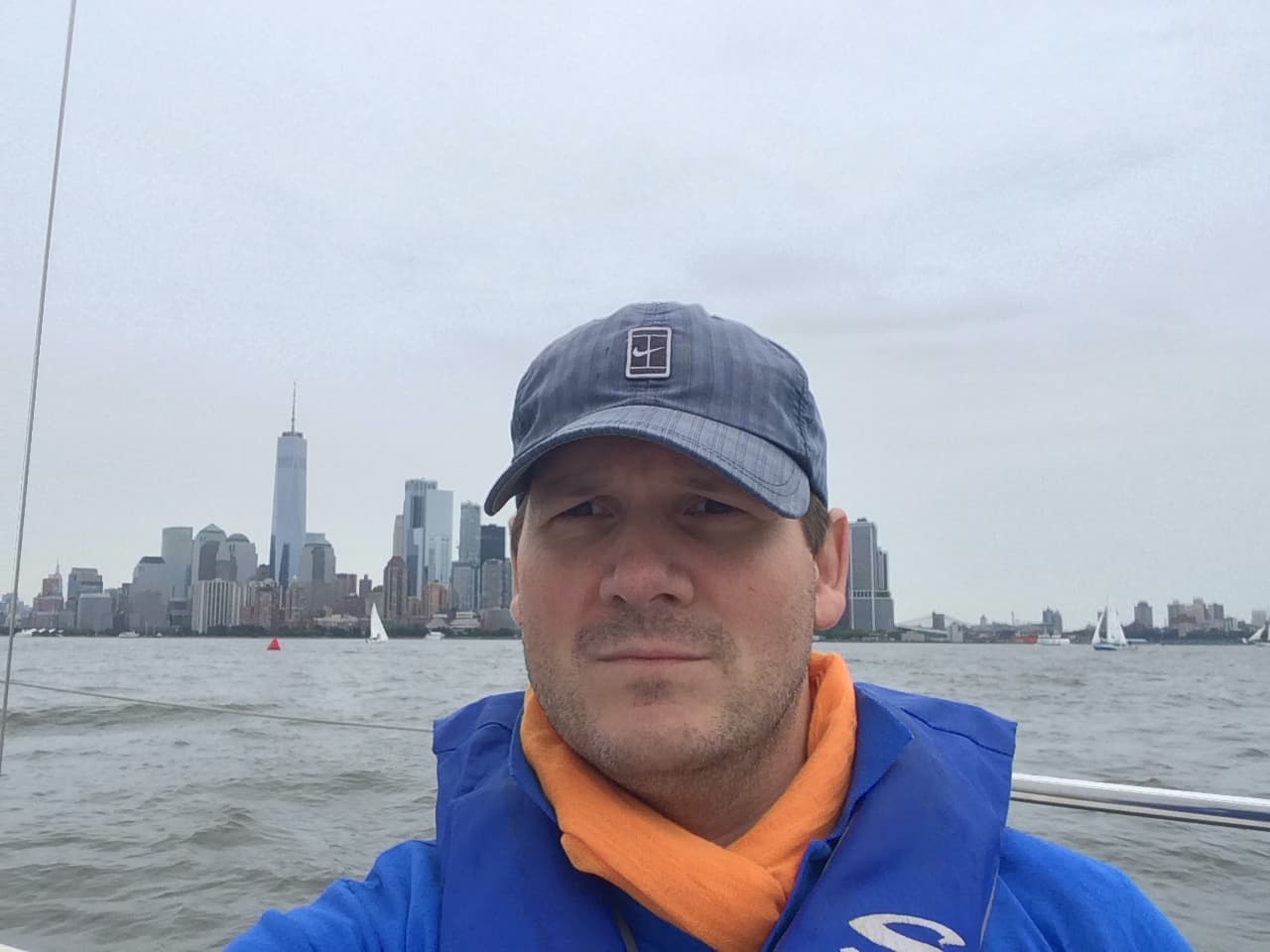
Photo (courtesy of Jean-Rodolphe): Jean-Rodolphe in NYC during AAGEF Regatta on June 2018
- Details
AFAM: Hello, Sacha, and thank you for participating in this interview series. Please tell us a few words about yourself. What are you doing today at Kaiko and what is this company about?
Sacha: Thank you for your invitation and for making this series! During my time at Arts et Métiers, I did an “S8” semester (which I think may not exist anymore) in Spain at UPV, then worked on wind-tunnel experiments for a space shuttle at the von Karman Institute in Belgium, moved to Paris to complete a double degree with a Research Master in Fluid Dynamics and Aeroacoustics during which I worked at Safran on the future of commercial aviation propulsion systems, and then moved to London to pursue a PhD sponsored by Innovate UK and Airbus at Imperial College on the physics of turbulence for drag reduction. After this, I embarked on a journey to entrepreneurship that started at an AI venture founded by a friend from Imperial, then went on to study business and finance at MIT before a failed attempt to start my own company in the space of financial inclusion. Right at that time, Kaiko was closing a seed round of financing and looking to expand to the US market. Kaiko is a market data provider that focuses on building reliable data infrastructure for crypto currencies, we sit at the intersection of finance, crypto, and tech, and operate both in the centralized and decentralized ecosystems. My role has been to open our US office and work with our engineering and business teams to improve our product as well as initiate our research efforts, in order to showcase our data and help clients make valuable use of it.
AFAM: From your LinkedIn profile we learned that prior to joining the crypto space, you were running computer simulations for the Aerospace industry. How can you explain this change? What was your motivation to switch to the financial sector? And how did you get where are you now?
Sacha: The funny thing is that I was technically running crypto calculations slightly before I got to get into Aerospace simulations. I first heard about a new electronic cash protocol on the amazing podcast Security Now (to which I still listen regularly, I highly recommend it!), it then took me some time to get to it and it was already too late to mine Bitcoin on my cheap personal laptop when I eventually did during my time at Arts et Métiers (my laptop had about 30min of battery life running CATIA V5), still, I did manage to mine some Dogecoin! It did not take long though until I decided to dedicate this CPU usage to more scientifically productive calculations like studying the flow around a cylinder using a Boltzmann solver.
The desire to move to the financial sector arose slowly over time. I guess the 2008 crisis occurring when I was in high school did not act as a catalyst when I was making long-term plans of what my career would look like after starting my undergrad. Later, during my Research Master, I joined a team of engineers at Safran Aircraft Engines in the Paris area to work on aerodynamic performance of propellers. I really loved this time spent at Safran where the team was outstanding both on management and engineering sides. At the same time, I started wanting to understand how corporate decisions were made, for example: “Should we improve our existing engine, or should we build a new one with a new technology?” Of course, real-life questions are not as simple and binary as this, especially given the long development cycles seen in aerospace, but it does illustrate when you try to come up with an answer that engineering is only one piece of the puzzle. As frustrating as it may have been at the time for me to realize, most of this answer may come from a subtle combination of politics (public and internal), regulatory constraints, competitive dynamics, and (surprisingly for me back then) long-term predictions of oil prices.
I took a break from those considerations during my PhD at Imperial College London and shifted my focus to bringing a solid contribution to science. Although it was a challenging time, just as it should, I count those years as some of the best of my life. Little economic considerations, no politics (apart from a sudden exit from the European Union…), two incredible PhD advisors, life-long friends amongst the PhD cohort, the only things that mattered were intellectual curiosity and understanding the world we live in. “The world we live in,” or perhaps more realistically a pixel of its infinite picture. I was running numerical experiments on turbulence; it would take days of computing on tens of thousands of CPUs but then you would get a simulation so precise that the statistics would almost perfectly match a corresponding real-life experiment. I felt I had a distilled a little bit of nature and I was running it from my computer. I could visualize it in real time, pause it, then restart it, kill it, nurture it, all this from the tip of my fingers. Sometimes the turbulence would die in the simulation so you would have to crank it up a little, and then I would check at night that the vortices looked healthy in the simulation, making sure the flow made its “transition” to a turbulent state so that I would have some statistics to aggregate the following morning.
Speaking of transitions, how did I make mine to finance? After a rather unexpected series of events, my interest in the venture world led me to go from Imperial College, the birthplace of the most popular turbulence model (k-epsilon) to MIT, the birthplace of the most popular financial model (Black–Scholes–Merton). At the end of the day, investing is about understanding how the world and our society work. Understanding finance is essential if you wish to lead impactful projects, understand how decisions are made, and the cherry on top is that you get to work with passionate and smart people. I believe that blockchain and crypto currencies make for a compelling narrative that acts as a catalyst to apply cryptographic technologies at unprecedented scales. As an aside, I have not closed the door to aerospace, and I am confident that much of what I am learning now will be transferable if I have the opportunity to get back to it one day.
AFAM: What do you think is the best way or one of the ways to start in financial engineering especially for our students at Arts et Metiers with a major focus on mechanical and industrial engineering?
Sacha: There are many paths to financial engineering and many skills learnt in mechanical and industrial engineering are transferable to finance. There are a lot of data science techniques that are very much transverse between engineering and finance, just beware that the signal-to-noise ratio can be frustratingly lower in finance. If you know how to perform a statistical test to ensure that your production is meeting your quality requirements, you can apply that to finance. Having a strong understanding of statistics will open many doors in financial engineering. In addition to the buzz words like machine learning and AI, numerical methods also come handy: The methods for solving partial differential equations are the same in engineering and finance, just as you are solving a constrained optimization problem for solving the production planning of your supply chain, you can do the same to optimize a portfolio of stocks. However, bear in mind that there is more to finance than financial engineering and there are other areas of finance that may appeal to you.
AFAM: Andrew Sheng, a Hong-Kong based Malaysian Chinese banker, named by “Time” in 2013 “One of the 100 most influential people in the world” in an interview for the 2010 financial industry documentary “Inside Job” said: "Why should a financial engineer be paid four to a hundred times more than a real engineer? A real engineer builds bridges. A financial engineer builds dreams and, when those dreams turn out to be nightmares, other people pay for it." What do you think about it?
Sacha: My first reaction to this would be to think of scalability. When you build a bridge, a lot of the work you have to do is bespoke, less scalable, and the risks you bear are much more visible and understood in general. Engineers have spent centuries understanding bridge failures, yet we don’t understand everything: the Tacoma bridge collapsed in the 1940s due to aeroelastic instabilities. Since then advances have been made and the revolution in computer simulation is for sure contributing to the improvement of the models being used to prevent this from happening again. However, faulty engineering does also come with consequences (material, social, and financial), and other people are paying for them. Don’t get me wrong though: I am not implying that engineers should pay for it!
On the other end, financial engineers have their own models to describe the arcane financial system, they build bridges between risk pools so that projects can happen. When a crisis strikes, some of those bridges collapse and, in part under the pressure of regulators, financial engineers update their models to prevent similar collapses from happening again. Scalability means you can easily replicate those bridges in other places, however it also means that they can all blow up at the same time when a vulnerability brought to light.
I would argue that engineering has been catching up, it is scaling and starting to face some similar issues. We see this with artificial intelligence and computer security. Disparities consequently arise in salaries: take a PhD in Computer Vision and compare their salary to a mechanical engineer working on bridge design, I suspect they are not of the same order of magnitude. Pushing this scalability one step further will take you back to the previous series of interviews you did on People and Robots: add robots into the mix and you introduce scalability for building and servicing the real world too!
Humans work and operate in networks; modern technology brought us from advancing at the speed of evolution and generation, to advancing at the speed of thought. In a sense this is good for Progress (I try to remain optimistic on this), but sadly, network effects increase disparities and a simple thought experiment suffices to illustrate this point: imagine you get valued by the number of people you talk to. Now just think of the difference between an Instagram influencer with millions of followers and someone living a happy life in the countryside mostly interacting with their close family and friends, you will find many orders of magnitude between the two. Going back to the physics of turbulence, I would say that reducing friction increases the separation between scales, but I won’t bore you with this any further.
AFAM: financial sector is very popular among our students today. What would be your advice to those who will be looking for internships in a financial sector (including in the USA in 2021 as soon as the situation with visas is resolved)?
Sacha: The first thing is to have a general understanding of the many facets of finance. For this, I encourage students to reach out to alumni working in the space to learn how they got where they are and what they are working on (do not forget to contact Shasta program first!). There are many ways to get exposure to finance especially quantitative finance, you can look at open projects, many platforms allow you to test algorithm without putting any real money behind it. Having skin in the game is key for a financial practitioner but there is a lot you can learn before getting to this point. Also have a look at Numerai, and if you are interested in the quant side, there are now many other resources available online. Two other projects worth mentioning are Quantopian and Quandl.
Finance is as broad as its applications. Engineering skills are particularly valued in quantitative finance but there are other areas of finance like Venture Capital that can provide an interesting blend of finance and engineering where your technical expertise in a field can be an edge.
Finally, I’d say find something you are passionate about and start building your professional network early with an open mind. Be ready to adapt, the rate of change is accelerating. Last but not least, in whatever you engage in, always remember that building for a better world is far more rewarding in the long term!
AFAM: Thank you for your time, Sacha!
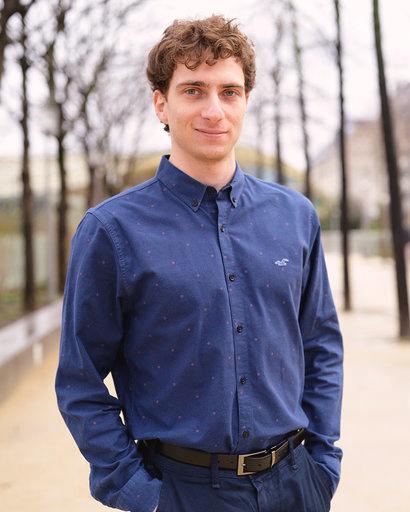
Photo: courtesy of Sacha and Kaiko
More about Kaiko:
Other resources:
- Remote internship: what's your point of view?
- "People and Robots" #3 - interview with Audren Cloitre (An 208), a Research Scientist at Analog Garage, a branch of Analog Devices Inc.
- "People and Robots" #2 - interview with Ryan Lober (Class 212), co-founder and CEO at Fuzzy Logic Robotics
- Why consulting?... replies Adrien Monvoisin (Cl 204), consultant at Deloitte
- "People and Robots" #1 - interview with Thomas Gurriet (Cl 212)

 BLOG /
BLOG /  CALENDAR /
CALENDAR /  DONATIONS /
DONATIONS /  MENTORS /
MENTORS /